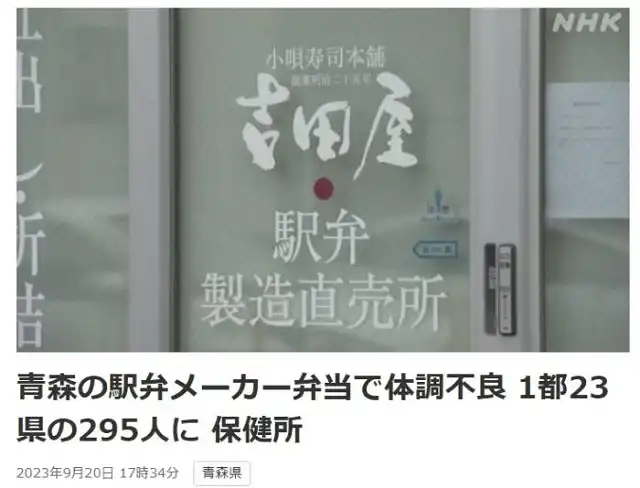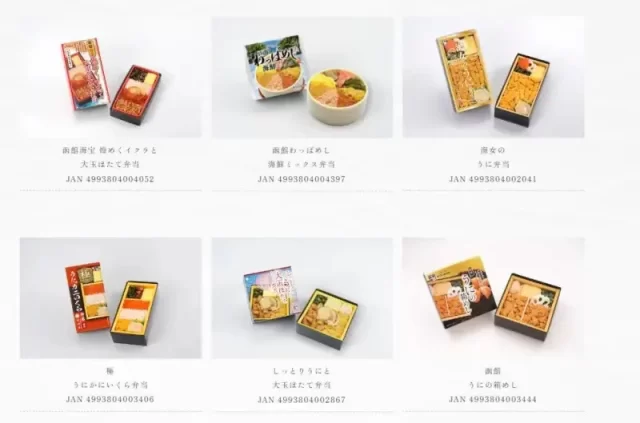Nearly 300 People Food Poisoning in Japanese 130-Year-Old Restaurant
- Normal Liver Cells Found to Promote Cancer Metastasis to the Liver
- Nearly 80% Complete Remission: Breakthrough in ADC Anti-Tumor Treatment
- Vaccination Against Common Diseases May Prevent Dementia!
- New Alzheimer’s Disease (AD) Diagnosis and Staging Criteria
- Breakthrough in Alzheimer’s Disease: New Nasal Spray Halts Cognitive Decline by Targeting Toxic Protein
- Can the Tap Water at the Paris Olympics be Drunk Directly?
Nearly 300 People Food Poisoning in Japanese 130-Year-Old Restaurant | 「吉田屋」“人気駅弁”約300人食中毒
- Should China be held legally responsible for the US’s $18 trillion COVID losses?
- CT Radiation Exposure Linked to Blood Cancer in Children and Adolescents
- FDA has mandated a top-level black box warning for all marketed CAR-T therapies
- Can people with high blood pressure eat peanuts?
- What is the difference between dopamine and dobutamine?
- How long can the patient live after heart stent surgery?
Nearly 300 People Food Poisoning in Japanese 130-Year-Old Restaurant.
Japanese Railway Bento Brand Hit by Food Poisoning, Nearly 300 People Experience Nausea and Diarrhea After Consuming “Yoshidaya Bento”.
A collective food poisoning incident has occurred in Japan, with reports of people across the country experiencing symptoms such as nausea and diarrhea after consuming bentos produced by a railway bento manufacturer called “Yoshidaya.” As of Tuesday (the 19th), at least 295 people have reported being affected, spanning nearly 40 regions nationwide.
The bentos produced by “Yoshidaya” are not only sold at JR stations from Hokkaido to Kyushu, including locations like Hachinohe and Aomori Prefecture but are also available in supermarkets throughout Japan.
“Yoshidaya” has expressed deep apologies to its customers and is cooperating with the investigation led by the Hachinohe City Health Department.

Image source: Screenshot of Japan Broadcasting Association (NHK) report
Incident Reported in 40 Regions Where Supermarkets Sell Nationwide:
Multiple Japanese media outlets have reported that on the 17th of this month, the Health Department of a certain city in Fukushima Prefecture notified the Hachinohe City Health Department about several individuals experiencing discomfort after consuming bentos sold by the local railway bento manufacturer “Yoshidaya.”
Upon further investigation by the Hachinohe City Health Department, as of the morning of the 20th, at least 295 people from at least 40 regions across the country have reported discomfort, including vomiting and diarrhea, after consuming “Yoshidaya” bentos.

Yoshidaya announced on its official website that 11 types of lunch boxes have been discontinued. (Picture/reproduced from Yoshidaya official website)
Production Halted Pending Investigation:
The Hachinohe City Health Department is currently investigating the patients’ dietary habits and changes in their condition.
If it is confirmed to be a case of food poisoning, a detailed examination of the factory will be conducted.
The Health Department advises the public to avoid consuming a total of 11 bento varieties produced by “Yoshidaya” between the 15th and 16th of this month, including the “Sea Urchin Bento” and “Hakodate Assorted Seafood Wooden Box Bento.”
It is estimated that around 20,000 bentos were sold during the “Railway Bento Expo” held in supermarkets nationwide on the 16th and 17th, and the exact number sold cannot be determined at present.
Founded in 1892, “Yoshidaya” has offered approximately 70 different railway bentos. Following this incident, the company expressed on its official website, “We deeply apologize for disappointing our customers who were looking forward to purchasing our bentos.” Until the cause is identified, “Yoshidaya” will temporarily cease production and sales of bentos.
The President of “Yoshidaya,” Hiroki Yoshida, also responded, saying, “We deeply apologize to the customers who purchased our bentos and experienced discomfort. We hope that those whose health was affected will recover soon, and we are cooperating with the investigation conducted by the Hachinohe City Health Department to determine the cause of the incident.”
What factors caused food poisoning?
According to a study published by the Japan Science and Technology Agency, food poisoning was the top food safety concern of surveyed Japanese people for almost every year since 2008.
However, the number of cases has decreased in the past 15 years with 1,330 infections in 2018.
In 2021, a total of 717 food poisoning incidents were reported in Japan, a decrease from around 887 cases in the previous year.
There were approximately 11.1 thousand patients in Japan that suffered from those incidents in 2021.
The causes of food poisoning in Japan vary depending on the type of food, the season, and the region. Some of the common causes are:
Bacterial contamination:
This is the most common cause of food poisoning in Japan, accounting for about 80% of the cases.
Some of the bacteria that can cause food poisoning are Salmonella, Campylobacter, Staphylococcus aureus, Clostridium botulinum, and Escherichia coli.
These bacteria can contaminate food through improper handling, storage, or cooking.
They can also be transmitted from animals or humans to food. Some of the symptoms of bacterial food poisoning are diarrhea, vomiting, fever, and abdominal pain.
Viral infection:
This is another common cause of food poisoning in Japan, accounting for about 10% of the cases. Some of the viruses that can cause food poisoning are Norovirus, Rotavirus, Hepatitis A, and Hepatitis E. These viruses can contaminate food through fecal-oral route, contact with infected persons or animals, or contaminated water. Some of the symptoms of viral food poisoning are nausea, vomiting, diarrhea, and jaundice.
Parasitic infection:
This is a less common cause of food poisoning in Japan, accounting for about 5% of the cases.
Some of the parasites that can cause food poisoning are Anisakis, Trichinella, Cryptosporidium, and Giardia.
These parasites can contaminate food through raw or undercooked seafood, meat, or vegetables. Some of the symptoms of parasitic food poisoning are abdominal pain, diarrhea, nausea, vomiting, and allergic reactions.
Chemical contamination:
This is a rare cause of food poisoning in Japan, accounting for less than 1% of the cases. Some of the chemicals that can cause food poisoning are Mushroom toxins, Pufferfish toxins, Heavy metals, and Pesticides.
These chemicals can contaminate food through natural occurrence, environmental pollution, or intentional adulteration. Some of the symptoms of chemical food poisoning are neurological disorders, respiratory failure, kidney damage, and death.
中毒につながる考えられる要因:
日本科学技術振興機構が発表した研究によると、食中毒は2008年以降ほぼ毎年、調査対象となった日本人の食品安全に関する最大の懸念事項でした。しかし、過去15年間で発生件数は減少し、2018年には1,330件の感染がありました1。2021年には、日本で合計717件の食中毒事故が報告されました。これは前年の約887件から減少したものです。2021年には、これらの事故で約11.1千人の患者が日本で苦しんだとされています。
細菌汚染:これは日本における食中毒の最も一般的な原因であり、ケースの約80%を占めています。食中毒を引き起こす可能性のある一部の細菌には、サルモネラ、カンピロバクター、黄色ブドウ球菌、クロストリジウム・ボツリヌム、エシェリキア・コリが含まれます。これらの細菌は、不適切な取り扱い、保管、調理によって食品に汚染されることがあります。また、動物や人間から食品に伝染することもあります。細菌性食中毒の症状には下痢、嘔吐、発熱、腹痛などがあります。
ウイルス感染:これは日本における食中毒の別の一般的な原因であり、ケースの約10%を占めています。食中毒を引き起こす可能性のある一部のウイルスには、ノロウイルス、ロタウイルス、A型肝炎、E型肝炎が含まれます。これらのウイルスは、糞口経路、感染者や動物との接触、または汚染された水を介して食品に汚染されることがあります。ウイルス性食中毒の症状には吐き気、嘔吐、下痢、黄疸などがあります。
寄生虫感染:これは日本における食中毒の比較的一般的な原因であり、ケースの約5%を占めています。食中毒を引き起こす可能性のある一部の寄生虫には、アニサキス、トリキネラ、クリプトスポリジウム、ジアルジアが含まれます。これらの寄生虫は、生または不完全に調理されたシーフード、肉、または野菜を介して食品に汚染されることがあります。寄生虫性食中毒の症状には腹痛、下痢、吐き気、嘔吐、アレルギー反応などがあります。
化学物質汚染:これは日本における食中毒のまれな原因であり、ケースの1%未満を占めています。食中毒を引き起こす可能性のある一部の化学物質には、キノコ毒、フグ毒、重金属、農薬が含まれます。これらの化学物質は、自然発生、環境汚染、または故意の混入によって食品に汚染されることがあります。化学物質性食中毒の症状には神経障害、呼吸不全、腎障害、死亡などがあります。
「吉田屋」“人気駅弁”約300人食中毒
Nearly 300 People Food Poisoning in Japanese 130-Year-Old Restaurant
(source:internet and youtube, reference only)
Disclaimer of medicaltrend.org
Important Note: The information provided is for informational purposes only and should not be considered as medical advice.



